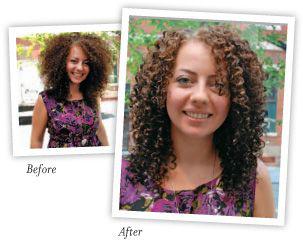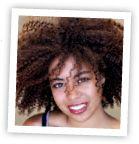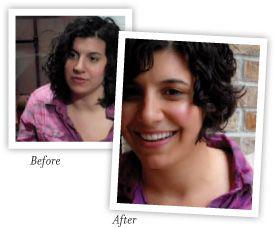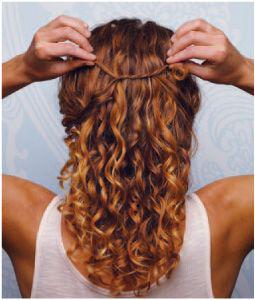B003YL4KS0 EBOK (35 page)
Authors: Lorraine Massey,Michele Bender

My jet-set trick is to cleanse and condition my hair the morning of the flight and scrunch in more gel than usual. Then I let it set in its gel cast for the duration of the flight so I can sleep or fidget for hours and still have frizz-free, moist curls on arrival. When it’s time to land, I tilt my head forward, shake it at the roots, and then gently scrunch upward to dissolve the gel cast and open hair to reveal bouncy jet-set curls.
Q
How do I avoid a bad case of the frizzies?
FRIZZ IS A DIRTY WORD
A
Frizz is a curl waiting to happen. Sometimes it’s shampooed hair begging for moisture (its natural survival requirement). But here’s how you can defrizz:

•
On rainy or high-humidity days, wet hair thoroughly and use extra conditioner to help elongate your hair so it goes in a north-south direction instead of an east-west one (see
page 30
).
•
Don’t linger too long in a steamy bathroom after showering. The humidity can open up the hair’s cuticle, causing a high frizz factor.
•
Another frizz-buster is giving curls one last cool rinse to seal the cuticle before styling. Fill a bowl with cool water, and if you’re really determined, put ice in it. Then dunk your hair in after you get out of the shower. Tilt forward, and with your hands scrunch out as much of the water and conditioner as you can. Then scrunch a palmful of gel in the hair, and when bringing your head to an upright position, graze extra gel or spray-gel on the canopy in a downward motion to keep the cuticle smooth.
•
Don’t touch your hair once you’ve applied gel, no matter how tempted you are to pat the strands into place. This general rule for curly girls is particularly important on frizz-prone days.
•
If you have a special occasion like a prom or a date, here’s how you can protect your locks and encourage your curls to swell to their natural state with absolutely no frizz. After cleansing and styling (as
discussed above), spritz spray gel onto a silk scarf and loosely lay it over your hair. Clip the scarf at the back of your head and leave it on for 5 to 10 minutes. The scarf acts as a light weight that won’t allow the cuticle on the canopy of the hair to rise.
One more thought on the subject of frizz: It is not necessarily a bad thing. I personally like my halo at times, and I have clients who feel the same way. I think that if hair is healthy and the curls are basically well defined, a slight halo can be appealing. In fact, I’ve received many compliments on days when I haven’t fought the frizz too much. (Maybe I’m the only one who sees it!) I have long accepted frizz as one of the ways in which my curls choose to express themselves.
Q
How can I get rid of static?
HAIR-RAISER!
A
Most curly girls don’t have much of a static problem once they throw away the hairbrush, shampoo, and harsh electric appliances that create static blow-fly!
Use plenty of conditioner, especially on the canopy of the hair. If static and flyaways are still a problem, take a wet paper towel with gel in it, and graze gently in a downward motion over the top layer of your hair.

TIED IN A KNOTTie your curls back with your curls. To get your hair off your face or for end-of-the-day droop, try this pretty solution.
First, pull your hair back. Take a 1-inch section of hair from behind each ear. Cross the two strands over the rest of your hair and tie. Then pull a couple of curls out around the front to frame your face. For more on this look, see
page 172
.
Q
Why do I have knots at the nape of my neck?
WHAT KNOTS?
A
If you’re a breathing human being living in constant movement, accept the knots to be a part of daily life whether you’re curly or knot. I call it the maypole effect, when hair strands, which are falling off the head on a curved but fixed axis, spin when the head moves. To gently remove the knots, saturate them and surrounding hair with a botanical conditioner, which will prevent the hair from breaking and ripping. With one hand, isolate the knot and hold it between the thumb and forefinger. With the other hand, gently pry and release each strand of hair from the knot. Do not shred or pull, or you will fuse the open cuticle.
Q
Why do my ends become much drier and more brittle in the winter?
HAPPY ENDINGS
A
If your locks are shoulder length or longer, the ends are apt to be drier because your hair is constantly rubbing against the rough texture of fabrics like wool, coat collars, and scarves. (In the summer, there’s less friction with light, smooth fabrics.) There is not much you can do other than hypercondition and seal the ends with a silicone-free, alcohol-free product. And remember to gently remove any trapped hair out from under your coat, scarf, or bag handle! Also, try a late-winter trim.

Q
Will it ever be possible for me to have bangs?
FRINGE BENEFITS
A
Actually, it is possible to have funky, cropped bangs as long as you realize that they will never lie flat. Take two or three dry curls over your forehead, and have them cut shorter to frame and soften your face. Make sure they’re cut when the hair is dry (never wet), and don’t have them cut straight across. On days when your bangs simply won’t behave or they spring back too much, keep them weighted while the hair is drying by placing a clip at the end of each wayward curl. You can also create faux bangs with freshly cleansed and well-gelled hair. Just place clips at the concave bend of each wave to hold it in place as it dries, or if the hair is not newly cleansed,
spray it with water or a spray gel and then clip. This timeless romantic look “alludes” to bangs, similar to Rita Hayworth’s bangs, without committing to real ones.

Q
May I ever blow-dry my hair?
CURL, INTERRUPTED
A
No, because even one blow-fry can set you back. But if the weather is frigid and you’re in a rush to leave the house, you can use a blow-dryer with a diffuser on low to medium heat or a free-standing hooded dryer. I dry my curls by turning on the heat in my car, which creates a little microclimate that allows the moisture from the products to lock into the hair faster, keeps the hair cuticle closed, and evaporates the water.
Q
What’s the best way to tie back my curly hair or put it in a ponytail without causing breakage?
TIE ME UP, TIE ME DOWN
A
Use a fabric-covered ponytail holder, hair sticks or chopsticks, bobby pins, or a leather-covered clasp held in place with wooden sticks. You could stylishly use your own hair to put it back (see
page 151
). Never use rubber bands or any other kind of elastic with a closed metal clasp that can pinch, gnaw, and saw on your hair as your head moves back and forth. Also, make sure you don’t pull your ponytail back too tightly or your hairline will begin to recede.
Q
I know I have to give up my blow-frying and shampoo habits, but I’m afraid that if I go natural, my hair will look terrible. How long will it take before my curls start to look good?
ADDICTED TO GADGETS
A
If your hair is wavy, you’ll see more curls within three weeks; if you have Botticelli or corkscrew curls, it will take less time to notice a difference in
definition. Although your hair will love going natural, you may need some time to get used to your new look. “Everyone loves my newfound curls, but I am having an identity crisis!” is a typical in-recovery statement. Just take it one day at a time, learn what your curls want, not what you want, and seek to coexist in the hair and now. Your curls will look great even if they don’t conform to your exact vision. (Remember, your eyes have to adjust, too!) Abandon all the negatives and focus on the positives. Don’t compare your hair with others’!
Q
What’s the best way to protect my hair when swimming in the pool or ocean?
SWIM-IN-LOVE


